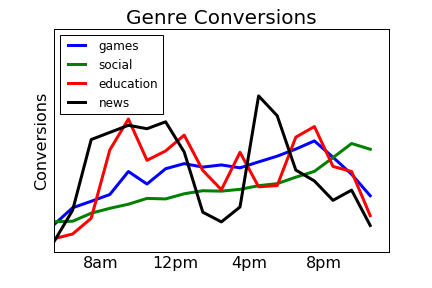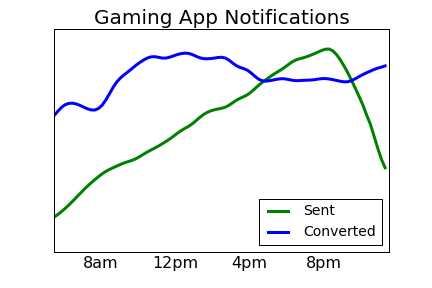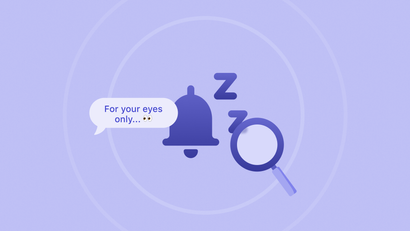As part of the Insight Data Science Program, I worked with OneSignal to tackle one of their data problems. OneSignal was kind enough to invite me to do a guest post here to quickly talk about the results of my work.
If you're interested in more specific details (e.g. modeling process and validation), I talk more in depth about this project on my blog.
The Project
If you own a mobile app, you know that push notifications are an important way to engage your users. My task was to find out when to send notifications to maximize the number of conversions.
Conversion: When a user clicks on the notification to get back into the app
Visualizing Conversions
The first thing I did was visualize when conversions happen during the day based off of the genre of the app. Here you can see the profile of some of the genres:

From here, we can see that different genres of apps can have wildly varying conversion patterns. Gaming apps have the most conversions at 8pm while news apps show two peaks of conversions, one in the morning (10am-12pm) and another in the afternoon at 5pm. If apps time their notifications at or preceding these times, they can better target and engage their users. Here are the peaks in number of conversions across the top 10 genres that OneSignal deals with:
- Games: 8pm
- Social: 10pm
- Education: 11am-1pm, 8pm
- Entertainment: 8pm-10pm
- Lifestyle: 12pm, 5pm, 9pm
- News: 10am-12pm, 5pm
- Business: 10am, 3pm, 7pm
- Travel: 9pm
- Health and Fitness: 12pm,
- Media and Video : 3pm, 7pm
Some things to keep in mind is that these peaks don’t correct for the pure number of notifications sent. For example, if the most notifications were sent at 8pm to gaming apps, you’d naturally expect more conversions during that following hour. Another caveat is the graph shows when conversions happened, regardless of when the notification was sent. OneSignal doesn’t keep track of the results of all the notifications sent in general, so I wasn’t able to correct for these.
Tracking Re-engagement Chances
Re-engagement notifications are only a subset of the notifications I looked at in the previous section. They’re especially important to track though as they’re targeted at users going inactive in order to reduce churn and extend the lifetime value of each user. The main question was how does the timing of the notification influence conversion chances. Below, you can see the results of my model for gaming apps.

Re-engagement notifications sent around noon have the best conversion chance. However, what gaming apps do in reality is send most of their notifications in the evening around 8pm. If OneSignal were to push these notifications earlier in the day, these gaming apps could retain an additional 10,000 users on a weekly basis alone. Extending this to the other genres with a large enough pool of re-engagement notifications gave the following optimal push times:
- Games: 11am-1pm
- Social: 10am, 11pm
- Education: 4pm
- Entertainment: 10pm
- Travel: 3-7pm
- Health and Fitness: 9am
The Takeaway
Unsurprisingly, genre has a huge impact on conversion chances throughout the day. I left you with some suggested timing patterns for notifications overall and then specifically for re-engagement notifications. I trust the re-engagement results more since those results don't come with any of the caveats I mentioned in the first section. In general, these are the results I've found and I'd encourage any app to take advantage of them to make their decisions more data driven. If you do, make sure to come back and tell us the end result!
*Editor's Note - This research was conducted using millions of data points from apps using OneSignal's SDKs
*Editor's Note - Please check out our follow up to the research conducted here on how OneSignal will use data science to optimize per user delivery



